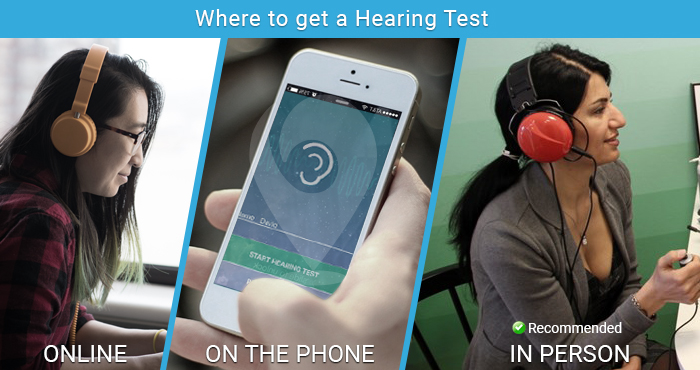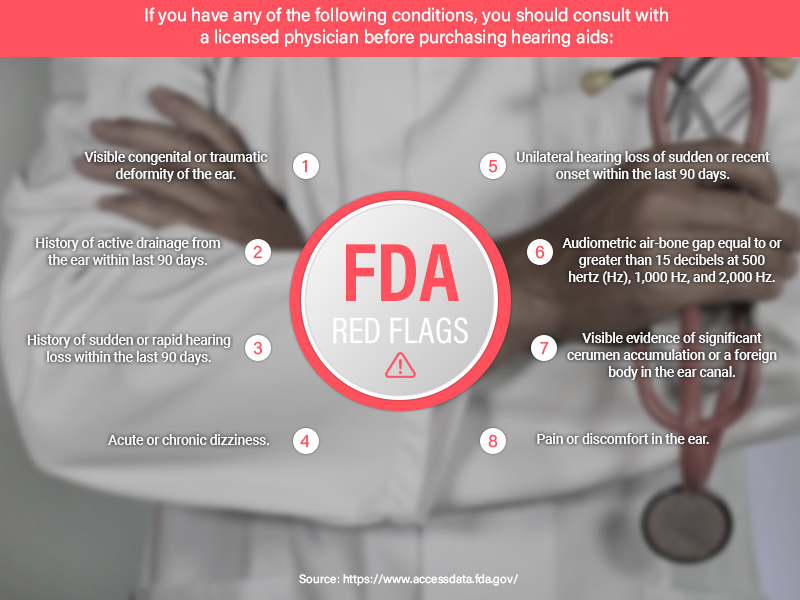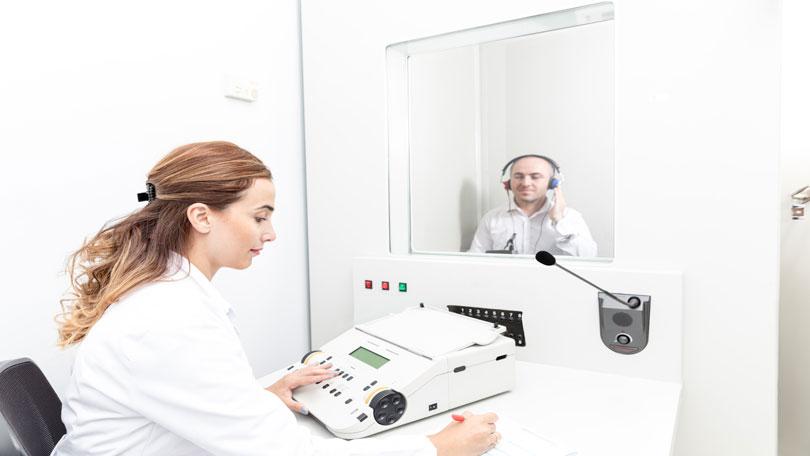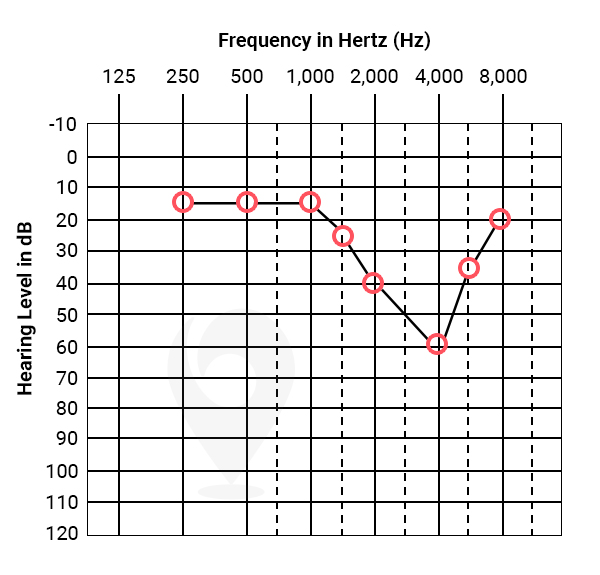Guide to Getting a Hearing Test
Types, costs, and what to expect
About 30% of adults have hearing loss by age 59. Half experience hearing difficulties by age 69.
The exact statistics vary based on the source, but it’s clear that your chance of having a significant hearing problem increases as you get older.
Hearing loss can have a major impact on your quality of life, potentially leading to social isolation, depression, and even dementia.
For these reasons and more, the American Speech-Language Hearing Association recommends that adults get a hearing test once every decade up to age 50. After age 50, you should get a hearing test once every 3 years.
This article will detail what exactly a hearing test is, where to get one, what you can expect, how much they cost, how to interpret your test results, and much more.
What is a hearing test?
A hearing test is an objective test to measure your hearing ability.
A basic hearing test administered by a hearing care provider has 3 primary objectives:
First, the test determines the softest level at which you can hear different tones. The softest levels at which you can hear tones will be compared to the normal hearing range for young adults.
Second, the test looks at how well you can understand speech. Being able to hear soft tones doesn’t always mean that you can understand speech, and this part of the test gives an idea of how well your brain processes sounds.
Third, the test looks for signs of medical conditions. If your hearing care professional sees something that might need treatment, he or she will tell you that you should see a doctor such as an Ear, Nose, and Throat (ENT) specialist.
Where to get a hearing test
Where or how you have your hearing tested may depend on how serious you perceive your hearing loss to be.
There are 3 ways to get your hearing tested.

Online: There are some online hearing tests offered by hearing aid manufacturers.
Over the phone: You can also find apps on your smartphone. There’s also a test you can take over the phone with the AARP.
In person (recommended): You also can get hearing tests at ENT offices, or from an independent audiologists or hearing instrument specialists.
Online and phone hearing tests are screening tests that help you get an idea of your hearing status.
These tests are not a substitute for a consultation with a hearing care professional who looks in your ear for wax and other problems, uses calibrated equipment and a sound booth, and discusses the results with you.
What to expect
Getting a hearing test is nothing to be afraid of. It's quick and painless.
In the video below, comedian and hearing aid wearer D.J. Demers shows what it's like to get a hearing test.
Parts of this video may not be appropriate for children ;)
A hearing test appointment for someone who is new to a hearing healthcare practice takes about an hour.
The testing itself takes about 20 minutes, with the rest of the time taken up with case history before the test and discussion of the results after the test.
You’ll be familiar with providing case history- it’s the same type of pertinent information you’d share with any new healthcare provider you visit.
The case history questions helps the professional know about health problems and medications that may impact your hearing, as well as make decisions about testing and referrals.
Once you’ve completed the case history, you’ll meet with your hearing care provider.
Usually at the start of the appointment, your hearing care provider will ask you a series of questions which may indicate the need for a referral to a licensed physician.
This list of potential issues to discuss is provided by the FDA, and is known as the “Red Flags.”

If any of these 8 items apply to you, your hearing care provider will refer you to a physician- at least before considering hearing aids as a treatment option.
If you know (prior to your appointment) that one or more of those points apply to you, you might as well save yourself the time, and book an appointment with your physician before you have your hearing tested.
Once done with the initial discussion, the health professional will look in your ears and make sure that you don’t have a wax blockage, infection, or another problem that could affect your test results.
The next step in the hearing test, is to actually do the test!
You shouldn’t experience any pain during the test, even though some procedures might feel a little uncomfortable for a brief moment.
If you feel any pain, let your provider know and he or she should stop immediately.
The professional will ask you to sit in a sound booth (shown below) or other sound-treated or monitored room.

You’ll likely be asked to wear a set of earphones, and to respond when you hear beeps and to repeat back some words.
After the test, the hearing care professional will explain the test results to you and his or her recommendations.
Types of hearing tests
There are certain tests that pretty much all professionals will do as part of a standard hearing evaluation:
- Air conduction: The professional places earphones on your ears and asks you to respond when you hear the beeps. This checks how well you hear when sounds have to travel through your entire ear from your outer ear to your inner ear.
- Bone conduction: The professional places a vibrator, mounted on a headband, behind one of your ears and asks you to respond when you hear the beeps. The vibrator sends sounds into your inner ear through the skull. This checks if there is something blocking sound from getting into your ear, like an ear infection or ear wax. Bone conduction testing is crucial, and helps your hearing provider determine the type of hearing loss you have.
- Speech reception threshold: You will be asked to repeat two syllable words like “playground” or “baseball”. This determines the softest level at which you can understand simple speech.
- Word recognition in quiet: You will repeat single-syllable words presented to you at a loud, but comfortable, level. This test measures how well you are able to understand words in quiet.
- Most comfortable level: The hearing care professional will talk to you at different volume levels until he or she finds the level that you report is most comfortable for you.
- Uncomfortable level: This can be done with both words and tones. The hearing care professional will gradually increase the level of the stimuli, and ask you to tell him or her when the tones or words are getting uncomfortably loud. This information can be used to help program hearing aids. Some people have extreme problems tolerating loud sounds (hyperacusis), which can be treated by a specialist.
- Speech recognition in noise: This test is less commonly done. If it is, you will be asked to repeat words or sentences presented in a background of noise. Since most people have more problems understanding speech in noise than in quiet, this test can provide useful information. Some people also have hidden hearing loss where they have normal hearing sensitivity (on the audiogram) but have problems hearing in noisy places, in which cases this test is very useful.
The above tests all depend on you being able to respond.
If you have a hearing test appointment with an audiologist, you may get some advanced testing where the results do not require a response from you.
This kind of advanced testing checks the physiology of your auditory system.
Physiological tests include:
- Tympanometry: The audiologist places a rubber tip from a machine in your ear canal and then introduces some pressure into your ear along with playing some tones. Through some physics and math, the machine calculates the size of your ear canal and how well your eardrum moves. This information can help determine if you have a problem with your middle ear, such as a hole in your eardrum or an ear infection.
- Acoustic reflexes: This test is similar to tympanometry, except that louder sounds are presented in order to test the action of muscles in your middle ear that respond to loud sounds. The reflex response depends on your auditory nerve, facial nerve, and some nerve circuits in your lower brainstem being intact.
- Otoacoustic emissions: During this test, a rubber tip is placed in your ear. You’ll hear a series of sounds. The audiologist measures sounds that are reflected back from your inner ear (cochlea) when you have a normal inner ear. This test can detect subtle damage to your inner ear from noise or medications before it shows up on an audiogram.
If hearing aids are ultimately recommended, many of the above test results will be used to help your hearing provider custom-program your hearing aids for your hearing loss and determine which type of hearing aid is appropriate for you.
Cost of a hearing test
We have surveyed the 700+ hearing providers we work with nationwide, an even mix of audiologists and hearing aid dispensers, and below are the prices they report charging for a complete hearing test.
Hearing test costs in the United States (Sample size = 690)
As shown above, a hearing test could be anywhere from free to $150+.
Whether or not there is a fee involved (and how much), usually depends on the type of hearing provider you see, and the complexity of the testing involved.
For instance, a hearing screening (just air conduction testing), is not a complete hearing test, takes just a few minutes, and in many cases is done at no charge.
A detailed hearing test, (like the kind mentioned above), may or may not cost you anything- that usually depends on the type of hearing care provider who conducts the test.
If your hearing test is conducted by a hearing instrument specialist, there usually will not be a charge. This is because some states don’t allow hearing aid dispensers to charge for their tests, or- a free hearing test is offered to encourage more folks to visit their practice and explore purchasing hearing aids.
If your hearing test is conducted by an audiologist, there will probably be a cost involved, due to a few reasons:
- An audiologist has likely earned a doctorate degree (a significant investment of time and money), and they deserve to be paid for their expertise- just like you would pay for an eye exam or dental checkup.
- An audiologist is able to perform more in-depth testing, which requires more of their time and of course the expense for the equipment necessary to administer these tests.
- Health insurance is more likely to pay for hearing testing conducted by an audiologist as opposed to a hearing instrument specialist. If an audiologist bills health insurance for testing, they usually cannot then offer that same service at no charge to private-paying customers, requiring them to charge all customers for a hearing test.
Does Medicare cover hearing tests?
Medicare and other health insurances may cover hearing testing if it is “medically necessary.”
“Medically necessary” means that the test is needed to help diagnose and treat a medical condition.
For Medicare, a physician must order the hearing test from the audiologist.
The physician, and the audiologist, must document that the hearing test is medically necessary.
For example, the test could be needed to determine if you have a hearing or balance problem that could be treated by medicine or surgery.
Medicare does not cover routine hearing testing for the purpose of obtaining, or programming, hearing aids.
It’s okay for an audiologist to bill Medicare for a hearing test that ultimately results in the recommendation to get a hearing aid.
The key is that the original reason for the hearing test must relate to symptoms that you’re having - hearing problems, balance issues, or tinnitus (ringing in the ears) - that indicate a potential medical condition.
Interpreting your test results
During your hearing test, you may see the hearing provider entering the results into their computer, testing equipment, or physically writing them down.
What they are doing, is creating an audiogram (shown below), which is a visual representation of your hearing loss.

As shown in the picture, the graph has marks on it that correspond to the softest sounds that you can hear across the frequency range.
In this case, the marks are red circles because in the hearing health world, red circles correspond to the right ear.
The vertical axis tells you how loud the sound had to be, in decibels, before you could hear it.
The closer that the marks are to the top of the graph, the better your hearing.
As the marks drift towards the bottom of the graph, your hearing gets worse.
The horizontal axis tells you the frequency of the sound, in Hertz.
Sounds on the left side are lower frequency, and sounds on the right side are higher in frequency.
If the circle marks are all at or above the 20 decibel line, you have normal hearing sensitivity.
The example audiogram shows a common hearing loss that we might see: normal hearing in the lower frequencies, with gradually worsening hearing at the higher frequencies.
How to convince someone to get a hearing test
Remember that no one likes being told that they have a problem and that they might need to make a change.
Do you really like it when your dentist tells you that you should be flossing?
Do you like it if someone tells you that you should lose ten pounds?
Similarly, you can’t (and shouldn’t) force anyone into a hearing test.
It’s a delicate act to bring up this issue to a loved one without sounding like a nag.
But you can do a few things to help someone realize that they should make an appointment with a hearing care provider.
Don’t be an enabler
Try to avoid becoming the “ears” of the person who has trouble hearing. Every time you “speak up” or make other accomodations for an individual with untreated hearing loss, you are giving them one more reason not to do something to correct the problem. So, if your spouse turns to you to ask you what was said at the dinner table by another person, tell them that they will have to ask the original speaker to repeat.
Let them know how it affects you
Be honest with the person about how the hearing problems are affecting your relationship. Try to have this conversation at a calm time (not in the middle of an argument), and share with him or her examples of how the hearing challenges have affected you.
Offer to go to the hearing test appointment with them, and get one yourself
When a hearing test is explained as a routine exam that is part of ensuring holistic health, in the same way that a physical is, it can feel less threatening. If you are both over 50, you can make the argument that it is recommended that everyone get a hearing test once every 3 years once they are over the age of 50.
Share your concerns with a loved one’s physician
Ask that it be discussed at the individual’s next appointment. People often will respect advice from a trusted physician.







Lily Bridgers
I’ve noticed my niece struggling to hear conversations and turning up the volume on her devices. My sister, swamped with work, hasn’t had the chance to address it. As a good aunt, I’ve decided to find a hearing test clinic for my niece. It’s crucial to rule out any potential issues early on. I appreciate you letting me know that the actual hearing test takes around 20 minutes; the remaining time is spent reviewing the case before the test and discussing the findings following the test. https://www.ahthearing.com/hearing-test
I’ve noticed my niece struggling to hear conversations and turning up the volume on her devices. My sister, swamped with work, hasn’t had the chance to address it. As a good aunt, I’ve decided to find a hearing test clinic for my niece. It’s crucial to rule out any potential issues early on. I appreciate you letting me know that the actual hearing test takes around 20 minutes; the remaining time is spent reviewing the case before the test and discussing the findings following the test. https://www.ahthearing.com/hearing-test